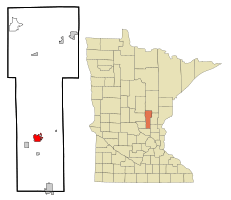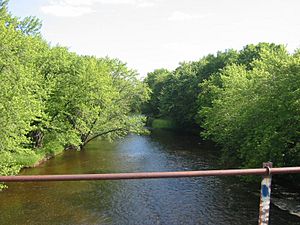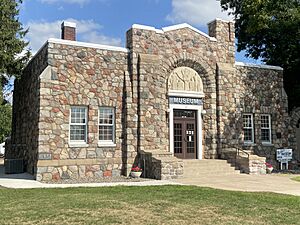Milaca, Minnesota facts for kids
Quick facts for kids
Milaca, Minnesota
|
|
|---|---|

1st Street W. and Central Avenue
|
|

Location in Mille Lacs County and the state of Minnesota
|
|
| Country | United States |
| State | Minnesota |
| County | Mille Lacs |
| Area | |
| • Total | 3.55 sq mi (9.20 km2) |
| • Land | 3.35 sq mi (8.67 km2) |
| • Water | 0.20 sq mi (0.53 km2) |
| Elevation | 1,079 ft (329 m) |
| Population
(2020)
|
|
| • Total | 3,021 |
| • Density | 902.87/sq mi (348.63/km2) |
| Time zone | UTC-6 (Central (CST)) |
| • Summer (DST) | UTC-5 (CDT) |
| ZIP code |
56353
|
| Area code(s) | 320 |
| FIPS code | 27-42110 |
| GNIS feature ID | 0647836 |
Milaca (/mɪˈlækə/ mih-LAK-ə) is a city and the county seat of Mille Lacs County, Minnesota. The population was 3,021 at the time of the 2020 census. It is situated on the Rum River.
Contents
History
A post office has been in operation at Milaca since 1883. The name Milaca is derived from shortening and alteration of Mille Lacs Lake.
Geography

Milaca is in southern Mille Lacs County. U.S. Highway 169 passes through the east side of the city as a four-lane bypass, leading north 25 miles (40 km) to Mille Lacs Lake and south 14 miles (23 km) to Princeton. Minneapolis is 64 miles (103 km) to the south. Minnesota State Highway 23 runs through Milaca south of its center, leading northeast 21 miles (34 km) to Mora and southwest 29 miles (47 km) to St. Cloud.
According to the U.S. Census Bureau, Milaca has a total area of 3.55 square miles (9.19 km2), of which 3.35 square miles (8.68 km2) are land and 0.20 square miles (0.52 km2), or 5.77%, are water. The Rum River passes through the west side of the city, flowing south to join the Mississippi River at Anoka.
Climate
| Climate data for Milaca, Minnesota, 1991–2020 normals, extremes 1897–present | |||||||||||||
|---|---|---|---|---|---|---|---|---|---|---|---|---|---|
| Month | Jan | Feb | Mar | Apr | May | Jun | Jul | Aug | Sep | Oct | Nov | Dec | Year |
| Record high °F (°C) | 60 (16) |
58 (14) |
81 (27) |
94 (34) |
107 (42) |
103 (39) |
108 (42) |
103 (39) |
104 (40) |
90 (32) |
74 (23) |
63 (17) |
108 (42) |
| Mean maximum °F (°C) | 40.4 (4.7) |
45.3 (7.4) |
59.7 (15.4) |
75.6 (24.2) |
86.1 (30.1) |
89.7 (32.1) |
90.5 (32.5) |
89.2 (31.8) |
85.8 (29.9) |
77.1 (25.1) |
59.0 (15.0) |
43.3 (6.3) |
93.0 (33.9) |
| Mean daily maximum °F (°C) | 20.4 (−6.4) |
26.0 (−3.3) |
38.4 (3.6) |
53.2 (11.8) |
66.4 (19.1) |
75.6 (24.2) |
80.1 (26.7) |
78.0 (25.6) |
70.4 (21.3) |
55.9 (13.3) |
39.1 (3.9) |
26.0 (−3.3) |
52.5 (11.4) |
| Daily mean °F (°C) | 10.5 (−11.9) |
14.8 (−9.6) |
27.6 (−2.4) |
41.8 (5.4) |
54.6 (12.6) |
64.7 (18.2) |
69.4 (20.8) |
66.9 (19.4) |
58.4 (14.7) |
45.0 (7.2) |
30.1 (−1.1) |
17.5 (−8.1) |
41.8 (5.4) |
| Mean daily minimum °F (°C) | 0.5 (−17.5) |
3.7 (−15.7) |
16.7 (−8.5) |
30.3 (−0.9) |
42.9 (6.1) |
53.8 (12.1) |
58.6 (14.8) |
55.8 (13.2) |
46.4 (8.0) |
34.0 (1.1) |
21.0 (−6.1) |
9.0 (−12.8) |
31.1 (−0.5) |
| Mean minimum °F (°C) | −23.8 (−31.0) |
−17.1 (−27.3) |
−6.7 (−21.5) |
17.1 (−8.3) |
30.6 (−0.8) |
40.6 (4.8) |
48.7 (9.3) |
46.2 (7.9) |
32.5 (0.3) |
21.7 (−5.7) |
3.8 (−15.7) |
−14.6 (−25.9) |
−25.6 (−32.0) |
| Record low °F (°C) | −48 (−44) |
−48 (−44) |
−32 (−36) |
−2 (−19) |
15 (−9) |
24 (−4) |
36 (2) |
32 (0) |
20 (−7) |
5 (−15) |
−22 (−30) |
−39 (−39) |
−48 (−44) |
| Average precipitation inches (mm) | 0.77 (20) |
0.85 (22) |
1.43 (36) |
2.74 (70) |
3.82 (97) |
4.31 (109) |
4.39 (112) |
3.97 (101) |
3.19 (81) |
2.82 (72) |
1.41 (36) |
1.11 (28) |
30.81 (784) |
| Average snowfall inches (cm) | 7.4 (19) |
11.1 (28) |
8.4 (21) |
4.4 (11) |
0.1 (0.25) |
0.0 (0.0) |
0.0 (0.0) |
0.0 (0.0) |
0.0 (0.0) |
0.8 (2.0) |
6.5 (17) |
10.2 (26) |
48.9 (124.25) |
| Average precipitation days (≥ 0.01 in) | 6.0 | 5.0 | 6.5 | 8.6 | 11.2 | 12.0 | 11.8 | 10.7 | 10.3 | 9.7 | 6.1 | 6.9 | 104.8 |
| Average snowy days (≥ 0.1 in) | 6.2 | 4.4 | 3.1 | 1.3 | 0.1 | 0.0 | 0.0 | 0.0 | 0.0 | 0.5 | 2.4 | 5.7 | 23.7 |
| Source 1: NOAA | |||||||||||||
| Source 2: National Weather Service | |||||||||||||
Demographics
| Historical population | |||
|---|---|---|---|
| Census | Pop. | %± | |
| 1890 | 404 | — | |
| 1900 | 1,204 | 198.0% | |
| 1910 | 1,102 | −8.5% | |
| 1920 | 1,347 | 22.2% | |
| 1930 | 1,318 | −2.2% | |
| 1940 | 1,627 | 23.4% | |
| 1950 | 1,917 | 17.8% | |
| 1960 | 1,821 | −5.0% | |
| 1970 | 1,940 | 6.5% | |
| 1980 | 2,104 | 8.5% | |
| 1990 | 2,182 | 3.7% | |
| 2000 | 2,580 | 18.2% | |
| 2010 | 2,946 | 14.2% | |
| 2020 | 3,021 | 2.5% | |
| U.S. Decennial Census | |||
2010 census
As of the census of 2010, there were 2,946 people, 1,308 households, and 691 families living in the city. The population density was 917.8 inhabitants per square mile (354.4/km2). There were 1,449 housing units at an average density of 451.4 per square mile (174.3/km2). The racial makeup of the city was 96.1% White, 0.4% African American, 1.4% Native American, 0.3% Asian, 0.1% from other races, and 1.6% from two or more races. Hispanic or Latino of any race were 0.6% of the population.
There were 1,308 households, of which 26.9% had children under the age of 18 living with them, 37.2% were married couples living together, 11.4% had a female householder with no husband present, 4.3% had a male householder with no wife present, and 47.2% were non-families. 40.6% of all households were made up of individuals, and 21.7% had someone living alone who was 65 years of age or older. The average household size was 2.12 and the average family size was 2.84.
The median age in the city was 39.7 years. 21.5% of residents were under the age of 18; 8.7% were between the ages of 18 and 24; 25.8% were from 25 to 44; 20.6% were from 45 to 64; and 23.5% were 65 years of age or older. The gender makeup of the city was 48.1% male and 51.9% female.
Education
Milaca Public Schools is composed of Milaca Elementary and Milaca High School. The elementary and secondary schools are connected to form one school toward the west of the city, along Highway 23 and the Rum River. There are approximately 1,900 students Pre-K through 12th grade, and around 130 teachers. The high school has a science and research forest. There are 11 varsity sports and reputable music and arts programs. The Star Tribune ranked the music program best in the state. Each summer the marching band receives very high rankings for their performances. The teams are the Milaca Wolves. There is also special education, community education, an Area Learning Center (ALC), and gifted education programming. Milaca also hosts the world's largest high school cross-country meet, The Milaca Mega-Meet.
ALC
The Milaca School District has an alternative high school that is separate from the main high school. The Milaca ALC (Area Learning Center) aims to educate students who need to repeat classes or have other life challenges and require a different education style and format. The ALC enrolls approximately 40 to 50 students ages 16–19, with four fully licensed high school teachers. Students can earn .5 credits per class in one quarter, as opposed to .5 credits per class in one semester at the high school. Classes are longer: an hour and a half for day classes and two hours for after-school classes. Several required courses can be completed as an independent study under the guidance and direction of the classroom teacher. The ALC offers no extracurricular activities, but students can participate in extra courses and activities at the main high school. While the majority of Milaca ALC students live within the Milaca School District, students from outside the district can enroll and earn credits for graduation. The ALC is many students' last chance to earn a high school diploma.
Infrastructure
Milaca is served by the Milaca Municipal Airport.
Major highways
The following routes pass through Milaca:
See also
 In Spanish: Milaca (Minnesota) para niños
In Spanish: Milaca (Minnesota) para niños


